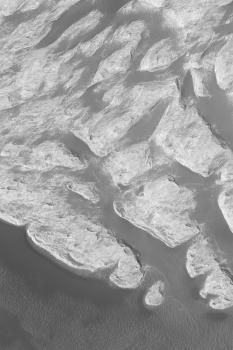
Mars Global Surveyor
Mars Orbiter Camera
"White Rock" of Pollack Crater
MGS MOC Release No. MOC2-592, 1 January 2004

NASA/JPL/Malin Space Science Systems |


NASA/JPL/Malin Space Science Systems |
The famous "White Rock" of Pollack Crater has been known for three decades; it was originally found in images acquired by the Mariner 9 spacecraft in 1972. This Mars Global Surveyor (MGS) Mars Orbiter Camera (MOC) close-up view, obtained in October 2003, shows some of the light-toned, wind-eroded sedimentary rock that makes up "White Rock." It is not actually white, except when viewed in a processed, grayscale image (in color, it is more of a light butterscotch to pinkish material). The sediment that comprises "White Rock" was deposited in Pollack Crater a long time ago, perhaps billions of years ago; the material was later eroded by wind. Dark, windblown ripples are present throughout the scene. This picture is located near 8.2°S, 335.1°W, and covers an area about 3 km (1.9 mi) wide. Sunlight illuminates the scene from the lower left.
Malin Space Science Systems and the California Institute of Technology built the MOC using spare hardware from the Mars Observer mission. MSSS operates the camera from its facilities in San Diego, California. The Jet Propulsion Laboratory's Mars Surveyor Operations Project operates the Mars Global Surveyor spacecraft with its industrial partner, Lockheed Martin Astronautics, from facilities in Pasadena, California and Denver, Colorado.